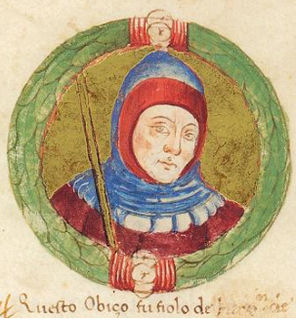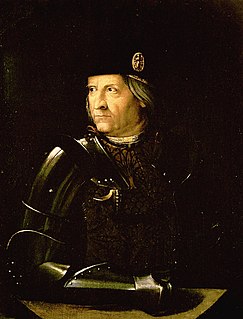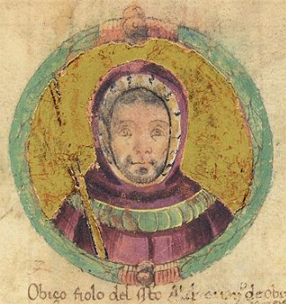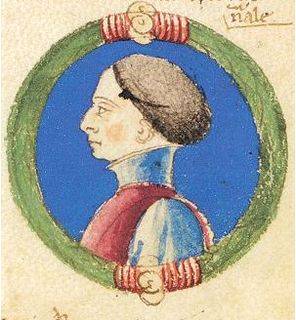
The House of Este was an Italian princely family, linked with several contemporary royal dynasties, including the House of Habsburg and the British royal family.

The Duchy of Modena and Reggio was a small northwestern Italian state that existed from 1452 to 1859, with a break during the Napoleonic Wars (1796–1814) when Emperor Napoleon I reorganized the states and republics of renaissance-era Italy, then under the domination of his French Empire. It was ruled since its establishment by the noble House of Este, and since 1814 by the Austria-Este branch of the family.

Emperor Frederick III conferred Borso d'Este, Lord of Ferrara, with the Duchy of Modena and Reggio in 1452, while Pope Paul II formally elevated him as the Duke of Ferrara in 1471, over which the family had in fact long presided. Nonetheless, this latter territory was lost to the Papal States in 1597, while the Estensi continued to rule the Duchy of Modena and Reggio in the Emilia until 1796, when it became part of Napoleon Bonaparte's Cispadane Republic. In 1814 the duchy was restored under the Habsburg grandson of the last Este Duke, continuing until annexed by Piedmont-Sardinia in 1859.

The House of Habsburg-Este, holders of the title of Archduke of Austria-Este, is a cadet branch of the House of Habsburg-Lorraine and also descends from the House of Este. It was created in 1771 with the marriage between Ferdinand of Habsburg-Lorraine and Maria Beatrice d'Este, only daughter of the Duke of Modena, Ercole III d'Este. After the death of Ercole III in 1803, the Modena ruling branch of the Este family's male line ended, and the Habsburg-Estes inherited his possessions in Italy.

Virginia de' Medici was an Italian princess, a member of the House of Medici and by marriage Duchess of Modena and Reggio.
The Battle of Zappolino was fought in November 1325 between forces representing the Italian towns of Bologna and Modena, an incident in the series of raids and reprisals between the two cities that were part of the larger conflicts of Guelphs and Ghibellines. The Modenese were victorious. Though many clashes between Guelphs and Ghibellines loomed larger to contemporaries than to historians, in this unusually large encounter between 4000 estimated cavalry and some 35,000 foot soldiers, 2000 men lost their lives. The location of the battle, at the foot of a hill just outside the castle walls, is today a frazione of the municipality of Castello di Serravalle, Emilia-Romagna.

The Duchy of Ferrara was a state in what is now northern Italy. It consisted of about 1,100 km2 south of the lower Po River, stretching to the valley of the lower Reno River, including the city of Ferrara. The territory that was part of the Duchy was ruled by the House of Este from 1146 to 1597.

Borso d'Este was Duke of Ferrara, and the first Duke of Modena, which he ruled from 1450 until his death. He was a member of the House of Este.

Barbara of Austria, was an Archduchess of Austria as a member of the House of Habsburg and by marriage Duchess consort of Ferrara, Modena and Reggio during 1565–1572.

Rinaldo d'Este was Duke of Modena and Reggio from 1694 until his death, as well as a member of the House of Este. He was succeeded by his son.

Alfonso III d'Este was Duke of Modena and Reggio from 1628 to 1629. He was the husband of Princess Isabella of Savoy, daughter of Charles Emmanuel I, Duke of Savoy and his wife Infanta Catherine Michelle of Spain.

Niccolò III d'Este was Marquess of Ferrara from 1393 until his death. He was also a condottiero.

Obizzo II d'Este was Marquis of Ferrara and Ancona.

Ercole I d'Este, KG was Duke of Ferrara from 1471 until 1505. He was a member of the House of Este. He was nicknamed North Wind and The Diamond.

Obizzo III d'Este was the Marquess of Ferrara from 1317 until his death.

Azzo VI, also known as Azzolino, was an Italian nobleman and condottiero. He held the title of Marquis of Este from the death of his father, Azzo V (1190) until his death.
Azzo (Italian) or Azzus (Latin) are variations of the same name. Azo, Atto, and Hatto are other variants.

Isabella of Savoy was a daughter of Charles Emmanuel I, Duke of Savoy, and Catherine Michelle of Spain. Her maternal grandparents were Philip II of Spain and Elisabeth of Valois, her paternal grandparents were Emmanuel Philibert, Duke of Savoy and Margaret of France, Duchess of Berry. She was the Hereditary Princess of Modena, dying before her husband succeeded to the Duchy of Modena in 1628.

Fulco I d’Este was the ancestor of the Italian line of the House of Este.

Rinaldo d'Este was a member of the House of Este.

















